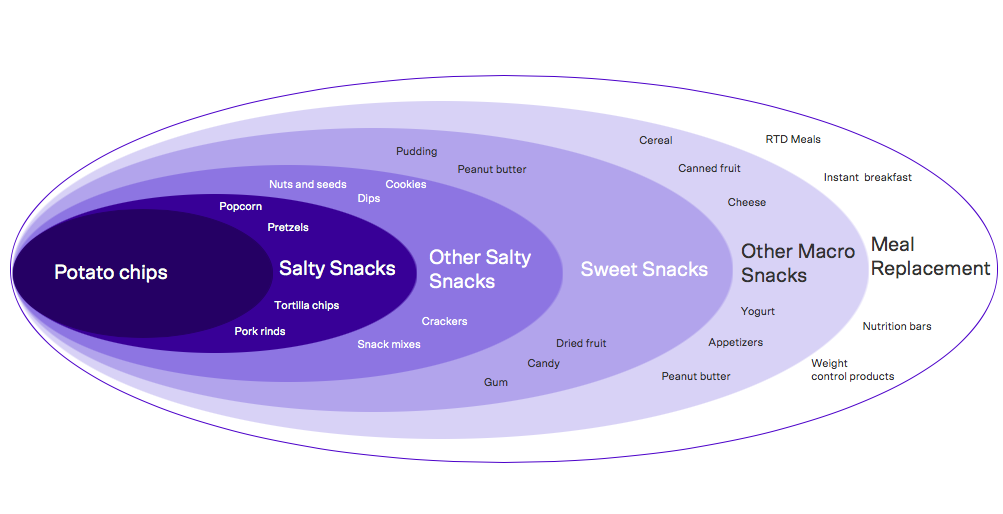Brand Positioning Fundamentals: Frame of Reference

Your company is struggling to stay competitive. How do you leverage consumer understandings to make a product that meaningfully creates value for customers?
A frame of reference approach engages an outside-in perspective to generate a better understanding of a business’s customers and what they need, creating a market or context in which a brand is positioned. It considers the wider set of products, services, brands, beliefs, and identities that hold the customer’s attention, to recognize the full range of products with whom the company competes.
Here, frames of reference can be understood as a broadening of a brand’s identity and capabilities and the ability of a product and company to meet specific consumer goals. These can include need states like seeking a healthier choice, enjoying authentic goodness, easy relaxation, lively engagement, and many others – ideas that may seem abstract in nature, but are effective ways to create substantial value for customers. By understanding the range of actors and products that a target consumer engages with and uses through this approach, companies can more holistically understand what pain points still exist for customers, as well as where their business might have an opportunity to expand their offerings.
What does a frame of reference approach look like in action?
Lay’s provides an excellent example for consideration. In the mid-2000’s, Frito Lay was struggling to maintain its competitive edge where it had once reigned supreme – in order to better understand their current market position and where they had room to grow, Vivaldi’s frame of reference approach helped to dive into the activities, behaviors, needs, and context to study the frame of reference in which snacking moments happen every day.
For Lay’s, a primary product is potato chips. Understanding the narrow industry of potato chips is an important starting place for creating a broader frame of reference that offers revealing insights about Lay’s and their competitors, as well as their customers. However, potato chips alone are not Lay’s only competitors. By thinking critically from a broader frame of reference, this approach creates a larger window of “pleasurable everyday snacks” as the market in which Lay’s was competing and could possibly expand into with more offerings.
 Moving layer by layer into the broader frame of reference surrounding Lay’s, the next, broader swath of the market consists of salty snacks, extending to items like cheese stick, pretzels, and pork rinds. From there, other salty snacks fall into a following layer of the frame of reference, including items like nuts and seeds, snack bars, and dips. Moving further, the next, extended layer of frame of reference includes sweet snacks (dried fruit, candy, gum, marshmallows), other macro snacks (cereal, canned fruit, peanut butter), and then finally, meal replacement (instant breakfast, nutrition bars, and weight control products). This broader category of “pleasurable everyday snacks” creates a more holistic market of competition for understanding Lay’s, enabling the business to understand what emotional drivers bring customers to their products.
Moving layer by layer into the broader frame of reference surrounding Lay’s, the next, broader swath of the market consists of salty snacks, extending to items like cheese stick, pretzels, and pork rinds. From there, other salty snacks fall into a following layer of the frame of reference, including items like nuts and seeds, snack bars, and dips. Moving further, the next, extended layer of frame of reference includes sweet snacks (dried fruit, candy, gum, marshmallows), other macro snacks (cereal, canned fruit, peanut butter), and then finally, meal replacement (instant breakfast, nutrition bars, and weight control products). This broader category of “pleasurable everyday snacks” creates a more holistic market of competition for understanding Lay’s, enabling the business to understand what emotional drivers bring customers to their products.
How does my company start to engage with this approach to improve our customer understandings and make products and experiences that meet those needs?
To generate a conversation about how your business can grow by using a broader target customer context and beyond narrow product categories starts with asking: what does the company traditionally offer? And then, moving to an outside-in approach, asking what customers truly care about and what category at a broader, more abstract level your company and product occupies? Followed by: who are the competitors in this expanded category? These questions can help to generate important insights to grow offerings, become more competitive, and consolidate positioning.